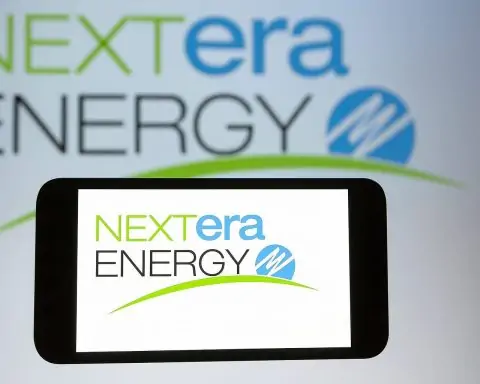- Current Stock Price: NXP Semiconductors (NASDAQ: NXPI) shares traded around $221 on Oct. 27, 2025, up about 1% after its earnings release (and roughly $224 in after-hours trading) [1]. The stock is down ~11% year-over-year but has climbed about +3.7% in the past 3 months [2]. Recent volatility saw NXPI dip to the $217 range last week amid industry jitters [3], before rebounding with earnings.
- Q3 Earnings (Sept. 2025): NXP’s quarterly profit was $631 million (about $2.48 per share, or $3.11 adjusted) – essentially matching Wall Street expectations [4] [5]. Revenue came in at $3.17 billion, a slight beat over the ~$3.15B forecast [6] [7]. The chipmaker noted “broad-based sequential improvement across all regions and end markets,” according to incoming CEO Rafael Sotomayor [8].
- Guidance & Outlook: For Q4 2025, NXP forecasted revenue of $3.2–$3.4 billion (versus ~$3.23B consensus) and adjusted EPS of $3.07–$3.49 (vs. ~$3.28 expected) [9]. This in-line outlook reassured investors after some rivals issued warnings. Notably, Texas Instruments had cautioned of weak auto chip demand, dragging NXP’s stock down ~2–3% in sympathy last week [10]. NXP’s management says its outlook reflects company-specific growth drivers and “signs of a cyclical recovery” in its markets [11].
- Market Sentiment:Analysts remain broadly positive on NXPI. Zacks Investment Research currently ranks the stock “Buy” (No. 2), noting recent upward earnings estimate revisions and a forward P/E (~18.5) well below the industry average [12]. Deutsche Bank recently named NXP a top semiconductor pick for the next year due to its strong execution in automotive and industrial chips and “reasonable” valuation [13] [14]. In mid-October, TD Cowen trimmed its price target slightly (to $260 from $270) but reiterated a Buy rating [15]. Overall, Wall Street expects modest growth ahead as auto demand stabilizes.
- Major Developments: NXP is the world’s #1 supplier of automotive semiconductors, and it’s navigating a soft auto market with strategic moves. Longtime CEO Kurt Sievers will retire at 2025’s end, and President Rafael Sotomayor is set to assume the CEO role on Oct. 28 [16] – a planned transition that initially rattled shares but is viewed as a smooth handoff. This year, NXP has been rebalancing its portfolio: it agreed to sell its automotive sensor business to STMicroelectronics for $950M [17] (shedding a non-core unit amid a sector slump) and has invested in growth areas like AI and software. For example, NXP acquired TTTech Auto (auto safety software) for $625M in January [18] and bought AI chip startup Kinara for $307M to bolster edge-computing capabilities [19]. These moves aim to strengthen NXP’s position in fast-growing segments (self-driving tech, AI at the edge) while remaining a dominant player in automotive and IoT chips.
Stock Price & Recent Trading Activity
NXP’s stock has seen choppy trading in recent days amid mixed signals from the semiconductor sector. Early last week, NXPI shares slid into the mid-$210s after peer Texas Instruments spooked the market with a dour outlook. TI reported soft demand for its chips and high customer inventories, sending its stock down ~7.5% and dragging NXP ~2–3% lower in sympathy [20]. On October 22, NXP closed around $217.16 – a multi-week low – on heavy volume, as investors reacted to signs of an industry slowdown [21]. This sector-wide selloff (which also hit names like Microchip and Qualcomm) reflected caution toward chipmakers, given “signs of a cyclical slowdown or inventory glut” emerging after the recent AI boom [22].
However, heading into NXP’s own earnings, the stock staged a rebound. By Monday Oct. 27, NXPI closed back above $220 [23], as some optimism returned. Moments after releasing its Q3 results, the stock ticked up about 1% in after-hours trading to roughly $224 [24]. The modest pop suggests traders were relieved that NXP’s numbers and outlook held no new negative surprises. Although the stock isn’t surging wildly, it has stabilized this week – a contrast to some smaller chip names that have swung dramatically on headlines. (For example, little-known Navitas Semiconductor’s stock rocketed over 700% this year on AI chip hype [25], highlighting the speculative extremes in the sector.) By comparison, NXP’s established business has made it a steadier performer in a turbulent chip market.
In terms of trading volume, NXP typically averages around 2 million shares per day. During last week’s volatility, activity spiked well above that norm – over 3.6 million shares traded on Oct. 22 alone [26] as many investors repositioned around the sector news. Volume remained somewhat elevated through the week, then normalized. This indicates that the market’s interest in NXP is high, with big institutional players likely adjusting their holdings in response to industry developments and NXP’s own earnings. So far, NXPI has outperformed many chip peers over the past month, falling only ~4–5% in that span versus a slight loss for the broader tech sector [27]. The stock is still well off its all-time high (~$284 in mid-2024) [28], but recent price action shows resilience as investors look for clarity on the chip cycle heading into 2026.
Earnings Report Highlights and Company News
NXP’s Q3 2025 financial results came in essentially as anticipated, reinforcing the narrative that the worst of the chip downturn may be passing. The Netherlands-based company reported net income of $631 million for the quarter, which equates to about $3.11 per share (adjusted) – exactly what analysts polled by Zacks had forecast [29]. In other words, NXP hit the mark on profitability. On the revenue side, sales of $3.17 billion slightly beat expectations (~$3.15B) [30], though they were down modestly (~2–3%) from the same quarter last year. This mild decline reflects lingering weakness in some segments, but importantly it was a smaller drop than earlier in the year, and sequential sales rose from Q2. NXP’s management highlighted that it saw “broad-based sequential improvement across all regions and end markets” during Q3 [31] – a positive sign that demand is stabilizing across its automotive, industrial IoT, mobile, and communications divisions.
Breaking down the business, automotive chips remain NXP’s bread and butter (around half of revenue). This segment has been under pressure as carmakers worked through a post-pandemic inventory glut and faced softer consumer demand for cars amid high interest rates. In Q3, NXP’s auto revenues were roughly flat to slightly down year-over-year, but the company noted improvement vs. the prior quarter, suggesting the auto chip slump may have bottomed out. In fact, some automakers are now resuming orders as their excess inventories clear. NXP’s industrial & IoT segment (factory automation, smart infrastructure, etc.) also showed hints of recovery, and its mobile segment grew year-on-year – helped by smartphone makers adopting more AI-enabled chips and 5G components. (Last quarter, NXP saw a 21% jump in mobile revenues as phone vendors upgraded devices with new AI features [32].) These trends indicate NXP’s diversification beyond autos is paying off, with AI and 5G tailwinds boosting demand in certain areas even as automotive waits for an upswing.
On the cost side, NXP has been managing expenses and maintaining healthy margins. Its adjusted gross margin was about 57% in Q3 [33], and free cash flow was robust ($509M in the quarter) [34] [35]. The company returned some cash to shareholders (about $54M in stock buybacks and $256M in dividends during Q3) [36] – a sign of confidence in its financial footing. NXP ended the period with a solid $3.45 billion cash reserve [37], giving it flexibility to invest further or weather any economic bumps.
Looking ahead, NXP’s forward guidance was about as “middle-of-the-road” as it gets – which, in the current environment, is actually welcome news. For the upcoming fourth quarter (Q4 2025), management expects $3.2 to $3.4 billion in revenue [38]. The midpoint of that range (~$3.3B) implies slight sequential growth and is just above Wall Street’s $3.23B consensus [39], despite macroeconomic headwinds. Likewise, the earnings per share (EPS) outlook of $3.07 to $3.49 encompasses analysts’ ~$3.28 forecast [40]. Essentially, NXP is guiding for a stable finish to the year, neither overly optimistic nor pessimistic. This in-line guidance helped allay fears that NXP might issue a profit warning like some rivals did. “Our outlook reflects the strength of our company-specific growth drivers and signs of a cyclical recovery,” said incoming CEO Rafael Sotomayor, underscoring that NXP sees its markets gradually improving [41]. He added that the company remains focused on disciplined investment and portfolio enhancements to drive growth, while controlling factors it can (costs, inventory) amidst external uncertainty [42].
It’s worth noting that leadership changes are underway at NXP, though they’ve been telegraphed well in advance. Current CEO Kurt Sievers – who has led NXP since 2020 and been with the firm for decades – will step down by Dec. 31, 2025. His successor will be Rafael Sotomayor, a company veteran who has been serving as NXP’s President and was the architect of much of its strategy. NXP announced this succession plan back in April, and Sotomayor officially becomes CEO at the end of October [43]. Initially, news of Sievers’ retirement and the accompanying guidance back in Q1 caused NXP shares to tumble ~7% in after-hours trading [44], as some investors fretted about a change at the top. However, sentiment has since calmed – Sotomayor is seen as a continuity candidate, and NXP’s board ensured a smooth handover (he took on the President role mid-year to transition). Under Sievers, NXP successfully navigated the 2021 chip shortage and expanded in key markets; Sotomayor is expected to continue that trajectory, with perhaps a greater focus on emerging areas like AI and software-defined vehicles. The leadership transition comes at a crucial time as the company pivots from playing defense (during the downturn) to going back on offense as demand recovers.
In terms of strategic business moves, NXP has been actively reshaping its portfolio in 2025 to sharpen its focus on high-growth opportunities:
- In July, NXP agreed to sell a chunk of its sensor business (which makes MEMS sensors for cars and IoT devices) to STMicroelectronics for $950 million [45]. Offloading this unit (about $300M in annual revenue) helps NXP streamline and raise cash, while STMicro gains tech to bolster its own automotive portfolio. The timing was notable – many chip firms have been facing weak automotive and consumer demand and bloated inventories [46], so NXP took the opportunity to divest a non-core segment and double down on its core franchises. This deal also underscores a trend of consolidation and cooperation in the industry as companies weather the downturn by trading assets and focusing on what they do best.
- Earlier in the year, NXP made acquisitions to boost its capabilities in ADAS (advanced driver-assistance) and AI. In January 2025, it announced a $625M purchase of TTTech Auto [47], an Austrian firm specializing in automotive safety software (middleware for self-driving and automated driving systems). This brings in over 1,100 software engineers and important relationships with carmakers, enhancing NXP’s push into the “software-defined vehicle” era. The integration of TTTech’s software with NXP’s auto processors (branded “NXP CoreRide”) is aimed at helping automakers develop next-gen electric and autonomous vehicles faster [48]. And in February, NXP also said it would acquire Kinara, a small Silicon Valley AI chip startup, for ~$307M [49]. Kinara develops edge AI processors – think chips that can run machine-learning tasks in cars or IoT devices without needing the cloud. This all-cash deal (expected to close by year-end 2025) shows NXP’s commitment to embedding AI capabilities in its product lineup, ensuring it can offer carmakers not just traditional microcontrollers, but also the intelligence needed for features like driver monitoring, vision processing, and autonomous control.
These moves illustrate NXP’s twin strategy: invest in future growth drivers (AI, software, electrification) while also optimizing its existing business through selective divestitures and cost discipline. Despite the soft patches in 2025, NXP continued to invest in R&D and strategic M&A, which could strengthen its competitive position when the cycle turns up. As one industry observer noted, many chip companies are using the downturn to focus on “high-growth niches” so they emerge stronger when demand rebounds [50]. NXP’s management seems to be following this playbook closely.
Analyst Views and Forecasts
Wall Street analysts, by and large, remain constructive on NXP’s prospects, even though the stock’s performance has been lackluster in 2025. The consensus view is that NXP is a solid long-term player in key markets (auto, industrial, connectivity) and is trading at a reasonable valuation. With the share price depressed from year-ago levels, some see an attractive entry point if the cycle indeed improves in 2026.
Notably, Deutsche Bank in early October highlighted NXP as a “leading investment idea” among semiconductors for the next 12 months [51]. The bank listed NXP as one of four Buy-rated chip stocks ahead of Q3 earnings, emphasizing that it likes companies with strong positions in AI/EV trends but still “reasonable” valuations (increasingly rare amid the AI hype) [52]. In Deutsche’s analysis, NXP benefits from “strong execution in automotive and industrial segments,” reaping rewards from the growth of electric vehicles and related chips [53]. They also praised NXP’s stable profit margins and disciplined capital allocation, which have boosted investor confidence [54]. In short, even as flashy AI-centric stocks (like GPU makers or niche AI startups) grabbed headlines this year, NXP is seen by some pros as a steady, underappreciated winner – a company that’s profitable, paying dividends, and well-positioned when car and IoT demand picks up. Insider Monkey dubbed NXP one of the “overlooked AI stocks to buy now,” since it quietly enables AI at the edge (in cars, factories, etc.) without the frothy valuations of pure-play AI firms [55].
Price target-wise, most analysts are in the mid-$200s. For example, TD Cowen’s analyst Joshua Buchalter recently reiterated an Outperform (Buy) on NXPI, though he trimmed his target price to $260 (from $270) on October 10 [56]. This tweak likely reflects near-term macro caution (higher interest rates can temper auto sales), but Cowen’s stance implies substantial upside from current levels. Firms like Truist have also raised targets (to ~$264) in recent months [57], and the median analyst target sits around the $240–$250 range, indicating expectations of a rebound as earnings grow next year. It’s worth noting that despite 2025’s earnings dip, the Street expects NXP’s 2024 to be a recovery year: consensus sees full-year 2024 EPS around $11.70 (down ~10% vs. 2023) and revenue ~$12.1B (down ~4%), but then a return to growth in 2025 [58]. If those forecasts hold, NXP’s forward P/E ratio is roughly 18x, which undercuts the broader chip industry’s average (near 30–40x) [59]. This discount suggests the stock is pricing in a lot of caution (auto exposure, macro risks), but could rerate higher if the company delivers even modest growth and the auto cycle improves.
To be fair, not everyone is pounding the table – there are risks that analysts flag. A few have pointed out that China’s economic malaise and EV slowdown could pose headwinds (China is NXP’s single largest country market, accounting for ~33% of revenue [60]). If Chinese demand for cars and smartphones stays weak, NXP’s sales there might stagnate. Also, some note that microcontroller and analog chip markets (NXP’s breadbasket) saw a massive boom during the pandemic and could face a longer digestion period. Inventory corrections at customers (especially car OEMs) have lasted a bit longer than initially expected. And competition is always a factor – for instance, rivals like Infineon, Texas Instruments, and STMicro are vying for the same automotive sockets, and all are pushing into next-gen chips for EVs and autonomous driving. However, NXP has so far held its own, often being the incumbent supplier in many car electronics systems (from radar sensors to secure car access chips).
On balance, the tone from the analyst community is cautiously optimistic. As evidence of sentiment: Zacks Investment Research recently highlighted NXP for “surpassing market returns” and maintained a Buy rating, citing the company’s positive earnings revisions and attractive valuation [61]. The Zacks Rank for NXPI is #2 (Buy) as of late October [62], reflecting upward estimate momentum. And in its earnings preview, Zacks actually predicted NXP would beat Q3 estimates [63] – which was essentially on point. Analysts will be watching the next few quarters closely to see if NXP’s “sequential improvement” continues and if the anticipated growth in automotive and industrial end-markets materializes. Any clear signs of an auto-chip rebound (or accelerated gains from NXP’s new AI/ADAS products) could prompt upgrades or higher price targets, whereas setbacks in those areas would do the opposite.
Semiconductor Industry & Macro Context
NXP’s fortunes are closely tied to the broader semiconductor cycle, especially the trends in automotive electronics, industrial equipment, and Internet of Things devices. Over the past few years, the chip industry has swung from extreme shortages (in 2021–22) to an inventory glut in 2023–25 for certain chip types. This cyclical whiplash hit NXP’s core markets: automakers that were desperately hoarding chips a couple of years ago found themselves overstocked and pulled back on orders in late 2024 and 2025 [64]. As high inflation and rising interest rates cooled consumer demand for cars and gadgets, manufacturers became more cautious. “Clients in the automotive industry have been pulling back on orders on tepid demand as customers await an improved macroeconomic environment and interest rate cuts,” Reuters noted of NXP’s situation earlier [65]. Simply put, with car loans more expensive and the economy uncertain, car companies didn’t want to overbuild inventory, which meant fewer chip orders in the short term.
This dynamic created a mini-downturn for many semiconductor firms focused on autos and industrial electronics. We saw that in Texas Instruments’ recent warning and STMicro’s results – in fact, STMicro just forecast its own Q4 sales below expectations due to weaker auto demand, which sent its shares down in late October. ST even posted its first quarterly loss in a decade as it wrote down excess inventory [66]. Such reports underscore that the chip slump hasn’t entirely gone away. TechStock² analysts warned that after the big AI boom in early 2025, some chipmakers are now feeling the hangover: “there are signs of a cyclical slowdown or inventory glut emerging” in semis [67]. Inventory levels are a key metric – many companies built up stock when supply chains were strained, and are now working it down. The good news is NXP’s management indicates that inventory correction is progressing, and by mid-2026 the auto and industrial supply-demand should be in better balance. Already, NXP’s own days of inventory have normalized, and customers are reported to be nearing normal stocking levels.
Meanwhile, one segment of the chip world is in a full-blown boom: anything related to AI computing. 2025 has seen a frenzy for high-performance AI chips (GPUs, specialized accelerators) and the components that support them. Nvidia’s stock soared to record highs as its data-center AI chips are in scorching demand, and this enthusiasm spilled over to certain smaller players – as mentioned, a power-chip maker like Navitas exploded 700%+ on an Nvidia partnership for AI data centers [68]. Analog chipmakers that cater to AI hardware (power management, high-speed networking chips, etc.) also got a boost. NXP is not a direct competitor in the data-center AI processor space, but it stands to benefit indirectly from the AI trend in a few ways. First, AI is increasingly being deployed “at the edge” – e.g. in cars (for driver assistance, vision systems), in smart home devices, in factories – and NXP’s microprocessors and sensors play a role there. Second, the overall tech excitement around AI has kept up investment in electronics broadly, which helps the ecosystem. However, NXP’s stock did not see an AI-fueled pop like Nvidia or AMD; if anything, it was somewhat overshadowed as investor capital chased the more glamorous AI plays. This could actually be a positive now – NXP’s valuation didn’t inflate into a bubble, and as one analyst noted, “reasonable” valued chip stocks became “increasingly rare” amidst the AI mania [69]. NXP might represent a case of a fundamentally strong company that could attract renewed interest if the AI narrative broadens to include auto and edge computing (areas where NXP is essential).
In the automotive chip arena, a major secular trend is the rise of electric vehicles (EVs) and more electronic content per car (for safety systems, connectivity, autonomy, etc.). NXP, along with Infineon and Renesas, is at the heart of this, supplying key chips for EV power management, battery systems, radar/lidar, and more. EV sales are growing globally (with some ups and downs in 2025), and governments are pushing stricter emissions standards which should boost EV adoption. While NXP’s recent auto slump was cyclical, the long-term demand curve for auto semiconductors is rising, since an electric or self-driving car can use 2-3x more semiconductors (by value) than a traditional gas vehicle. For instance, Navitas’s gallium nitride power chips (mentioned earlier) are one niche targeting faster EV charging and AI datacenters [70]. NXP itself has plenty of skin in the game: its chips are used in advanced driver-assistance systems (ADAS), EV battery management units, and vehicle networking. This is why analysts like Deutsche Bank remain bullish on NXP for EV/AI trends [71]. Automakers’ tech tie-ups are also accelerating – note that NXP’s chips and newly acquired software (TTTech Auto) are aimed at enabling the shift to software-defined vehicles, where updates and features are delivered via code. It’s a competitive field (Nvidia and Qualcomm are also vying to supply “digital chassis” platforms for cars), but NXP’s deep relationships with car OEMs are an advantage.
Another important context is geopolitical and macroeconomic factors. Being a European chipmaker (headquartered in Eindhoven, Netherlands), NXP is affected by both U.S. and EU tech policies. In recent years, the U.S.–China trade war and export controls on chips have cast a shadow. China is NXP’s largest end market, accounting for roughly one-third of sales [72], so any restriction on selling to China or any Chinese retaliation could impact demand. This year saw continued tensions – the U.S. has tightened export bans on advanced chips to China, and China in turn has been investing heavily in domestic chip production (especially older-generation “legacy” chips) to become more self-sufficient [73]. If Chinese chipmakers ramp up output of certain analog or MCU chips, that could introduce new competition for NXP in some segments (especially lower-end chips). Furthermore, China launched some regulatory moves, like a surprise antitrust probe into Qualcomm in October, which sent Qualcomm’s stock plunging 7% in one day [74]. That incident highlighted the regulatory risk for foreign chip firms in China – at any time, companies like NXP could face hurdles ranging from antitrust reviews to nationalist favoritism toward local suppliers. So far NXP has navigated this without major issue, but it’s an area to watch.
On the flip side, government support for semiconductors in the West is a tailwind for NXP. The EU and U.S. have both passed “Chips Acts” dedicating billions to encourage more chip manufacturing and R&D domestically. NXP itself has manufacturing in Europe and Asia, and it even formed a joint venture to expand a silicon wafer fab in Singapore (with a partner, Vanguard) [75] – partly to diversify production away from China. The U.S. CHIPS Act incentives might not directly involve NXP (it’s more for factories which NXP mostly outsources to partners like TSMC), but overall it means a more robust supply chain and possibly easier access to government contracts (in areas like secure communications, etc., where NXP has products). Global supply chain considerations have eased since the height of the pandemic – chip lead times are down, and shipping logistics are smoother – but new risks have emerged, such as rising energy costs in Europe and even the Israel–Hamas conflict which has implications for tech (Israel is a semiconductor hub and conflict can affect markets for certain materials). Recently, Japanese automakers were warned of potential chip supply disruptions due to geopolitical tensions, reminding the industry that supply chains remain vulnerable to shocks.
Finally, macroeconomic factors remain a big variable for NXP. Interest rates are at multiyear highs as central banks battled inflation. High rates have particularly hit interest-sensitive markets like automobiles and housing (which in turn affects appliances, etc., and thus chips). If in 2026 we see central banks start to cut rates as inflation cools, that could spur a rebound in auto sales and consumer spending on electronics – directly benefiting NXP’s top line. Conversely, if rates stay “higher for longer” and economies slow, the recovery in chip demand could be anemic. Inflation also raises NXP’s costs (labor, materials), though the company has managed to preserve margins so far through pricing and efficiency. The U.S. dollar’s strength or weakness can impact NXP too, since it reports in USD but has a lot of non-U.S. operations; a strong dollar can weigh on reported revenue. As of late 2025, inflation has been moderating and many economists expect a mild global recovery in 2026, but it’s a watching brief.
In summary, NXP is operating in a complex environment: a semiconductor industry at an inflection point, where AI-driven euphoria coexists with pockets of cyclical weakness; an automotive sector transitioning to electric and smart vehicles but dealing with short-term oversupply; and a global backdrop of tech nationalism and high interest rates. NXP’s ability to navigate these cross-currents – by staying innovative (in AI, EV tech), maintaining customer trust, and being financially prudent – will determine how quickly its stock can regain momentum.
Expert and Investor Commentary
Industry experts and company executives have weighed in on NXP’s situation, offering insights into both challenges and optimism. On the cautious side, some market analysts urge vigilance given the late-2025 landscape. The team at TechStock² noted that even market darlings can stumble when expectations are high, pointing out that tech stocks “priced for perfection” have no margin for error [76]. In NXP’s case, the stock’s valuation is not stretched, but the broader chip rally (fueled by AI hopes) has been very narrow. “The recent tech rally has been extremely narrow – some fear it’s ripe for a pullback,” the TechStock² report warned [77], referencing how a handful of mega-cap tech names drove much of 2025’s gains. If any of those falter or if AI enthusiasm cools, the spillover could affect sentiment for all tech, including steady performers like NXP. Additionally, concerns about overvaluation in certain “hot” areas (like smaller AI and quantum computing stocks) have led experts to advise investors not to chase hype blindly [78]. This context suggests that NXP’s more grounded performance could actually work in its favor – it hasn’t been bid up on unrealistic expectations, so it may be less vulnerable if a tech bubble deflates.
From the company’s leadership we’ve heard a mix of realism and confidence. CEO Kurt Sievers has repeatedly emphasized navigating uncertainty. “We are operating in a very uncertain environment influenced by tariffs with volatile direct and indirect effects,” Sievers said back in the spring [79], alluding to the trade tensions and macro volatility. That mindset has kept NXP cautious in forecasting and spending. Meanwhile, his successor Rafael Sotomayor strikes an optimistic tone about NXP’s unique opportunities. He highlighted that NXP’s growth is driven by secular trends and that the business saw improvement across all end markets sequentially [80] – a subtle pushback against the doom-and-gloom. Sotomayor also stated: “We remain focused on disciplined investment and portfolio enhancement to drive profitable growth, while maintaining control over the factors we can influence,” signaling to investors that NXP will continue to invest in R&D (for future growth) but keep a tight handle on costs and execution [81]. This balance of prudence and strategic investment is meant to reassure stakeholders that NXP is not simply cutting its way through the downturn, but actively preparing for the upturn.
Another perspective comes from investors looking at NXP in a portfolio context. Some view NXPI as a relatively defensive play within the tech sector – it has real earnings, dividends, and a broad customer base, which can make it safer than highly speculative tech bets. As one portfolio manager quipped, when AI hype stocks eventually face reality, “investors will rotate back into companies like NXP that have tangible earnings and reasonable multiples.” There’s also commentary around the auto semiconductor cycle: “Auto chip demand is cyclical, but the long-term trajectory is only going up with EVs and autonomy. If you can handle some bumps, NXP is a prime way to ride that megatrend,” said an analyst on a recent Yahoo Finance segment. This captures the idea that short-term turbulence (inventory corrections, etc.) shouldn’t obscure the structural growth story in NXP’s end markets.
Even competitors’ moves have drawn commentary relevant to NXP. When Qualcomm recently unveiled new AI chips for data centers, some analysts noted Qualcomm is diversifying beyond mobile and could see growth from AI – however, that also reminded markets that Qualcomm is under regulatory scrutiny in China, a fate NXP could share if U.S.-China relations worsen [82]. And when STMicroelectronics issued a cautious outlook and its stock fell, investors took it as a sign that “value-oriented chip names are at a bottoming phase” – essentially, the bad news might be largely priced in for companies like ST and NXP.
Furthermore, macro strategists have pointed out how interest rates and currency moves impact NXP. With the U.S. Federal Reserve possibly nearing the end of its rate hikes, some expect a tailwind for tech stocks: “If bond yields stabilize or drop in 2026, it could be a green light for beaten-down tech hardware names,” one economist told MarketWatch, mentioning NXP as a beneficiary due to its economically sensitive auto segment. Similarly, the Buffett Indicator (market cap vs GDP) being at historic highs [83] has some market bears worried about an overall correction, but even in that warning, they specifically cited “pricey tech stocks fueled by the AI boom” as most at risk [84] – implicitly excluding more reasonably-valued ones like NXP.
On the supply chain front, industry experts note that the worst supply snarls are over, but they caution about new disruptions. For example, a recent Just Auto report (via Yahoo Finance) warned Japanese automakers about potential chip supply disruptions due to geopolitical issues, which could tighten the market unexpectedly. Such events (be it a natural disaster in a semiconductor hub, or sanctions on a material like neon gas from Eastern Europe) could flip the script from glut back to shortage in certain chips. “The lesson from 2021–22 is that supply chains can turn on a dime – we went from famine to feast, and could go back to famine if we’re not careful,” an NXP operations executive said at a conference. NXP has tried to mitigate this by second-sourcing production and keeping close tabs on its suppliers. So far in 2025, there have been no major new supply crises, but both industry and governments remain vigilant.
In summary, commentary around NXP and its stock suggests a guarded optimism. Experts agree NXP’s core markets (auto/industrial) have a bright future driven by megatrends like electrification and AI, even if the present contains headwinds. The company’s leadership is projecting confidence in a gradual recovery, and many analysts endorse the view that NXP is a fundamentally strong player trading below its intrinsic value. At the same time, voices of caution remind us that macro and geopolitical risks haven’t vanished – high rates, China’s tech ambitions, and lofty market valuations could all yet test NXP’s steady course. For investors and observers, NXP Semiconductors stands out as a bellwether for the broader chip cycle: if its stock stabilizes and rallies, it may signal that the worst of the chip downturn is over and that the focus is shifting back to growth and innovation in semiconductors.
Conclusion
Bottom line: NXP Semiconductors N.V. is navigating a delicate moment where short-term challenges meet long-term opportunities. As of late October 2025, the company has delivered solid-if-unspectacular results, calming nerves that had been frayed by peers’ warnings. Its stock, while not immune to volatility, has held up relatively well through the recent tech turbulence – a testament to NXP’s status as a diversified, established player rather than a speculative high-flyer. The Q3 earnings confirmed that NXP’s business is holding steady, with strengths in areas like mobile and signs that its crucial automotive segment is bottoming out. Management’s steady guidance and talk of a budding recovery indicate cautious optimism heading into 2026.
Investors appear to be taking a “wait-and-see” approach on NXPI stock. The pieces are in place for a potential upswing – easing interest rates, revival in auto demand, and NXP’s own strategic investments in AI and next-gen vehicle tech. Should those drivers materialize, NXP could well accelerate again. In the meantime, the stock’s moderate valuation and the company’s ongoing profitability provide a measure of downside protection in a volatile market. As one might phrase it, NXP is down but not out – it remains a key player in the tech ecosystem, from the chips in our cars to the sensors in our devices, and it’s positioning itself for the future’s opportunities (AI at the edge, smarter cars, and beyond).
For the general public and investors alike, the recent story of NXP Semiconductors offers a microcosm of the larger semiconductor narrative: rapid innovation and growth potential tempered by cyclical swings and external uncertainties. At current levels, NXPI presents a tale of resilience – a stock that has weathered the storm and could be poised to ride the next wave, so long as the company continues executing and the macro winds turn more favorable. As always, those considering NXP should keep an eye on upcoming earnings, industry news, and macro shifts. But for now, NXP has given the market reason to breathe a little easier, proving that even amid chip sector gloom, it can steadily drive forward into the next phase of the tech cycle.
Sources:
- NXP Semiconductors Q3 2025 earnings release and estimates [85] [86] [87]
- NXP’s Q4 2025 guidance vs. consensus expectations [88]
- Stock performance data and recent price movement [89] [90]
- TechStock² analysis of chip stock volatility and sector warnings [91] [92] [93]
- Benzinga report on NXP’s earnings and executive quotes [94] [95]
- Reuters coverage of NXP leadership change and strategy (Sievers retirement, Sotomayor transition, Kinara acquisition) [96] [97]
- TechStock² report on STMicro’s acquisition of an NXP unit and industry downturn context [98] [99]
- Insider Monkey/Finviz compilation of analyst opinions (Deutsche Bank and TD Cowen on NXP) [100] [101]
- Zacks/Finviz insights on NXP’s valuation and rank [102] [103]
- Reuters reporting on automotive chip demand and China trade factors [104] [105]
References
1. www.benzinga.com, 2. ca.investing.com, 3. www.statmuse.com, 4. www.timesunion.com, 5. ca.investing.com, 6. www.timesunion.com, 7. ca.investing.com, 8. www.benzinga.com, 9. ca.investing.com, 10. ts2.tech, 11. www.benzinga.com, 12. finviz.com, 13. finviz.com, 14. finviz.com, 15. finviz.com, 16. www.reuters.com, 17. ts2.tech, 18. www.nasdaq.com, 19. www.reuters.com, 20. ts2.tech, 21. www.statmuse.com, 22. ts2.tech, 23. ca.investing.com, 24. www.benzinga.com, 25. ts2.tech, 26. www.statmuse.com, 27. finviz.com, 28. www.statmuse.com, 29. www.timesunion.com, 30. www.timesunion.com, 31. www.benzinga.com, 32. www.reuters.com, 33. news.moomoo.com, 34. www.benzinga.com, 35. www.benzinga.com, 36. www.benzinga.com, 37. www.benzinga.com, 38. ca.investing.com, 39. ca.investing.com, 40. ca.investing.com, 41. www.benzinga.com, 42. www.benzinga.com, 43. www.reuters.com, 44. www.reuters.com, 45. ts2.tech, 46. ts2.tech, 47. www.nasdaq.com, 48. www.nasdaq.com, 49. www.reuters.com, 50. ts2.tech, 51. finviz.com, 52. finviz.com, 53. finviz.com, 54. finviz.com, 55. finviz.com, 56. finviz.com, 57. www.nasdaq.com, 58. finviz.com, 59. finviz.com, 60. www.reuters.com, 61. finviz.com, 62. finviz.com, 63. finviz.com, 64. www.reuters.com, 65. www.reuters.com, 66. ts2.tech, 67. ts2.tech, 68. ts2.tech, 69. finviz.com, 70. ts2.tech, 71. finviz.com, 72. www.reuters.com, 73. www.reuters.com, 74. ts2.tech, 75. www.reuters.com, 76. ts2.tech, 77. ts2.tech, 78. ts2.tech, 79. www.reuters.com, 80. www.benzinga.com, 81. www.benzinga.com, 82. ts2.tech, 83. ts2.tech, 84. ts2.tech, 85. www.timesunion.com, 86. www.timesunion.com, 87. ca.investing.com, 88. ca.investing.com, 89. ca.investing.com, 90. www.statmuse.com, 91. ts2.tech, 92. ts2.tech, 93. ts2.tech, 94. www.benzinga.com, 95. www.benzinga.com, 96. www.reuters.com, 97. www.reuters.com, 98. ts2.tech, 99. ts2.tech, 100. finviz.com, 101. finviz.com, 102. finviz.com, 103. finviz.com, 104. www.reuters.com, 105. www.reuters.com






